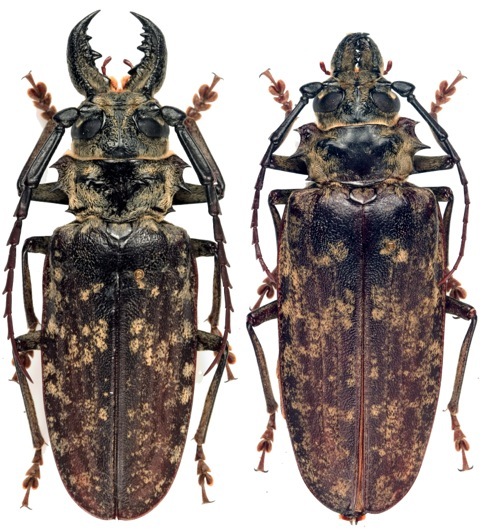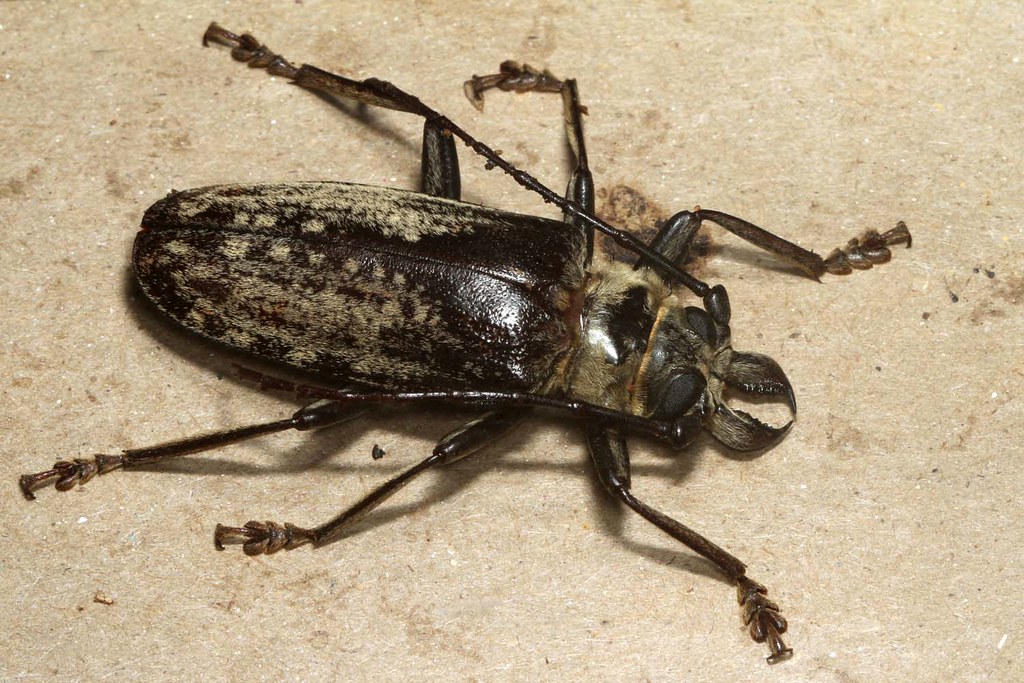Page 1 of 1
Tithoes (fmr. Acanthophorus) maculatus
Posted: Sun Nov 13, 2022 6:25 pm
by livingplanet3
Here's a real giant among the African Cerambycidae - Tithoes (fmr. Acanthophorus) maculatus, which can reach at least 95 mm -
 http://www.coleoptera-atlas.com/ceramby ... -maculatus
http://www.coleoptera-atlas.com/ceramby ... -maculatus
 https://www.prioninae.org/Especes/Acant ... latus.html
https://www.prioninae.org/Especes/Acant ... latus.html
 https://www.flickr.com/photos/mgrimm82/6363621013
https://www.flickr.com/photos/mgrimm82/6363621013
This species is widespread across equatorial Africa. Like the monotypic Titanus giganteus of the South American tropics, Tithoes is also in the subfamily Prioninae, but belongs to a different tribe (Acanthophorini).
Re: Tithoes (fmr. Acanthophorus) maculatus
Posted: Sun Nov 13, 2022 10:36 pm
by 58chevy
Looks scary! I wouldn't let my fingers get near those mandibles (male or female).
Re: Tithoes (fmr. Acanthophorus) maculatus
Posted: Tue Nov 15, 2022 12:21 pm
by Pierre
The first pictures shows Tithoes confinis (Lapoerte de Castelnau, 1840), male.
The pair on the second one should be T. maculatus (Fabricius, 1792) as the site says.
Third photo is most likely confinis again.
Re: Tithoes (fmr. Acanthophorus) maculatus
Posted: Tue Nov 15, 2022 5:54 pm
by livingplanet3
Pierre wrote: ↑Tue Nov 15, 2022 12:21 pm
The first pictures shows Tithoes confinis (Lapoerte de Castelnau, 1840), male.
The pair on the second one should be T. maculatus (Fabricius, 1792) as the site says.
Third photo is most likely confinis again.
These two species are often sympatric, are quite similar to each other, and the markings can vary considerably between individuals. Now, I'm wondering if the Tithoes specimens in my collection (labeled as maculatus), might actually be confinis.
http://www.coleoptera-atlas.com/ceramby ... -maculatus
http://www.coleoptera-atlas.com/ceramby ... s-confinis
https://www.google.com/search?q=%22Tith ... US903US903
https://www.google.com/search?q=%22Tith ... US903US903
Re: Tithoes (fmr. Acanthophorus) maculatus
Posted: Sun Dec 18, 2022 11:03 am
by africaone
what are the localities of these Tithoes ?
yes Pierre is right, 1 and 3 are confinis, but 2 can be frontalis or maculatus (two close sp, locality may be important as photos are not always sufficient)





